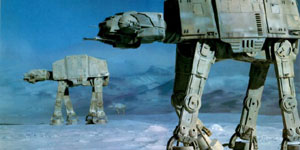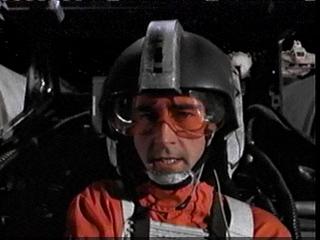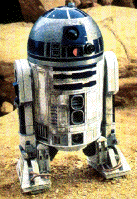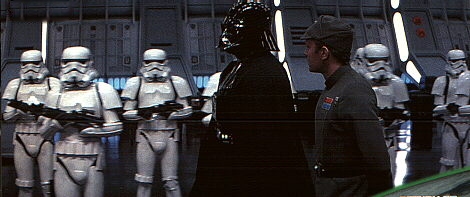How
to play in a Star Wars CCG Tournament...
By: Carl 'Mike' Hardy, Red
32
Step 2- Building the
Winning Deck.
Building a deck isn't as easy as it sounds.
For many of the best players, deck building
(some like to call it 'deck-tech') is an actual science! There are
tons of variables involved with building a sound deck: Which cards
go well with which cards? How many of what type of card should I
have in my deck? How can I squeeze all of this into only 60 card
slots!?!

I this section, I'll explain how the best
deck are constructed and show you where the traps and mistakes that can
befall typical deck building. Maybe even dispell some
of the common myths about the way decks are made.
A) Developing the 'Theme':
Most decks are based around a singular
'Theme'. A theme is a general term used to describe how the works
in tournament play. Often-times you can tell a decks theme almost
immediately... Other times you won't be able to figure them out at
all!
There are two main theme catagories that
a deck will fall into: Space or Ground.
A Space deck is geared to do most of it's
interaction at Systems or Sector locations. It will have only a token
ground force, if at all, consisting of a few very powerful cards.
Many players prefer this type of deck because its safer, in general than
it's Ground Based cousin. You see many character weapon that are
available (that work on the ground) can cause sever damage to your deck,
through reducing forfiet values (Forfiet =0 type weapons, like Vader's
Lightsaber). There are no starship or space-borne weapons that can
do that kind of damage. Thus, if you incorporate ways to reduce a
ground deck's Force drain advantage, you'll have a stronger chance of surviving
to win the game.
Here are the more popular decks that are
based on this theme:
-
Hidden Base- This very popular deck
style opens with the Hidden Base/ More Systems Will Slip Through Your Fingers
Objective. It concentrates on crippling the Dark Side's ability to
play be reducing his card drawing potential. It also has a strong
"built-in" Force drain reducer as well. There are many variations
to this style... Numbers (High Destiny droids and pilots with the
Effect Never Tell Me The Odds) and X-Wing Swarm (loads of non-unique X-Wings
powered by the S-Foils Effect) are a couple of the more popular ones.
These decks are known to make ample use of Enhanced Premier Pack mains
for quick strike ground offensives.
-
TIE's- With the introduction of the
Dreadnaught Class Heavy Cruiser, TIE's of all types have gotten a new lease
on life! Many start with a strong Force drain system location (Kashyyyk
is a favorite among many) or with Wakeelmui for Sienar Fleet Systems.
TIE's are generally inexpensive and have many Effects and Interrupts (Lateral
Damage and Tallon Roll, to name a couple) that can give them the edge over
Rebel space decks that aren't prepared for them. As a strong ground
defense, many of these decks use AT-AT walkers like Blizzard 2 and Tempest
1.
Opposite the Space deck, is the ground deck.
It's interaction is mainly at Site locations. It will only have a
few of the more powerful starships and maybe a nice Force drainable system
locaiton. Players favor this deck as it gives a lot of card economy.
Many of the main charcters in the game (Darth Vader, Obi-Wan Kenobi, Luke,
ect) work best on the ground (the only exception to this would be Capt.
Han Solo (as he was seemingly made for the Millenium Falcon)).
Additionally, many of these characters'
powerful weapons also have benefits on the ground (a Lightsaber's Force
drain +1 for example). Another attractive aspect of ground decks
is the plethora of heavy Force drain locations (Tatooine: Cantina, Endor:
Back Door or Hoth: Defensive Perimeter for instance).
Here are a few ground decks that you'll
likely see in today's tournament scene:
-
Hunt Decks- Powered by the Objective
Hunt Down And Destroy The Jedi/ Their Fire Has Gone Out Of The Universe,
Darth Vader, already a powerful Force in the game, has gotten even more
dangerous. These decks require Vader to occupy a battleground site
for their benefits to take hold. The Force lose from Visage Of The
Emperor and the inability for the Light Side to use Sense or Alter takes
it's toll relatively quickly. This forces a confrontation on the
Dark Side's terms... Often resulting in duels (which Obi is placed out
of play or Luke winds up joining the Dark Side), or battles against the
best the Imperial war machine can put on the table! While this is
generally a Ground style of deck, some Hunt variants are known to incorporate
high destiny TIE's (Scouts or Squadron craft (Black or Obsidian Squadron
TIEs).
-
Operatives- Despite the huge errata
Operatives received following their release in the Special Edition expansion,
thse types of decks are still quite common, and quite powerful! Both
Light and Dark Side have their own set of
 Operatives
(Bothawui, Raltiir, Corulag and Raithal operatives are the most favored).
Operative give the deck lots of speed, high Force drain potential and (when
their respective Objectives are flipped) additional power and battle destiny.
The built-in Force drain reduction granted by the Objectives are an added
benefit.
Operatives
(Bothawui, Raltiir, Corulag and Raithal operatives are the most favored).
Operative give the deck lots of speed, high Force drain potential and (when
their respective Objectives are flipped) additional power and battle destiny.
The built-in Force drain reduction granted by the Objectives are an added
benefit.
-
Mains and Toys- This is the most famous
(or infamous, depending on which side of the table your sitting...) type
of deck in tournaments today. They are also the oldest, having thrived,
inspite of just about everyone, since sanctioned tournament began.
Using expensive main characters (Vader, Grand Moff Tarkin, Obi, Luke and
others) and their equally expensive toys (lightsabers, Millenium Falcon,
Executor) it's overall card economy and effectiveness is unparralleled.
It can fight anywhere and it can Force drain for massive amounts.
It's been known to beat opposing decks by 40 or more cards (which is a
lot considering there are only 60 cards in the deck!).
B) Developing Card Interraction:
It's not enough to grab 60 of your favorite
cards and hope that they work together in a tournament. I see this
all of the time, too. Inexperienced players are romantisized with
the fact that they've got really cool looking rare cards and they simply
want to show them off. However, I'm here to tell you, a deck whose
cards work well together, even if their common or uncommon cards, will
be competitive and can even win.
Cards work together by developing combos.
You see these combos all of the time in card reviews on this website, the
Decipher webiste and other prominent websites. This card, plus that
card, does this. You know.
When building a deck, watch for really
great combos that mesh well with your deck's theme. Often, the key
is to understand how many cards are required to successfully pull of a
desired combo. Just because you have 60 cards doesn't mean that you'll
see each and every one of those 60 cards during a touranment game.
In fact, there've been times where Vader didn't appear at all during a
game I had... And, I had 3 in the deck!
This is where learning the nuance of the
deck comes in. Figuring out which combos can be pulled of early and
easily and which ones simply don't have the cards required to be very effective.
A rule of thumb for tournament play is
to avoid the monster combos. Although, they may be devestating and
really cool when they work, but, getting them to work before your opponent
Force drains you right out of the game, can be difficult. Generally,
three card combos (Like Han Solo, Chewbacca and Life Debt or Darth Vader,
his Lightsaber and You Are Beaten) are about as far as you'd want to go.
Many times, a player will devise a theme
based solely on a desired combos. The Corporal Drazin/ Special Delivery
combo, by it's nature, will beget a Carbon Freezing Objective based Ground
deck. Boba Fett and Hidden Weapons  could
spawn a Jabba's Palace style Ground deck. You see the picture.
could
spawn a Jabba's Palace style Ground deck. You see the picture.
Whether you choose to make a theme then
pick the combos or make the theme around the combos, just remember to keep
your combos simple and not so card intensive.
C) The fabulous foursome-
Monnock/ Grimtaash and Houjix/ Ghhhk:
Hot decks come and go... But, one
thing pretty much stays the same: The decks have multiples of cards
and they do battle damage. There are many occasions where I'll either
be saved or hurt by one of these little jewels. One thing is clear:
These babies are important.
I simply can't stress enough how usefull
and vasitile these cards are. Games have been won by a well played
Monnock. Games have been lost because the player didn't have a Houjix
in hand.
When building a deck always keep these
cards in mind. Try to keep the multiple card count down so you don't
become Monnock or Grimtaash bait. If you live in an area that thrives
on the use of these regulatory cards, and you've abolutely got to play
a Trooper deck, then think about limiting cards like Well Guarded, Yoda's
Stew or Cybernetic Implant.
D) Deck Building FAQ's:
-
How many locations should I have in my deck?
Normally, between 7 to 10 cards should be
devoted to locations. These locaitons should fit your overall theme
as well (Systems and Sectors for Space decks, Site for ground decks).
The exceptions to this would be if you play with Objectives or card that
allow you to search for locations. If you have the luxury of getting
the locatiosn you need, then you won't need to stock so many of them.
If you're playing an Objective, be sure
to remember to stock the required locations as depicted on the italicized
deploy instructions on the Objective card.
-
Do I need to have weapons in my deck?
Not at all! Weapons are not required
to battle nor are they required for characters to deploy. They are
merely activators which provide you with more advantages in a battle.
Many deck have no weapons at all.
-
I don't have very many main characters, but,
I want to play a ground deck anyway. What should I do?
There are many common cards out there that
can be used to protect your mains during the course of the game.
Talz, the Septoid Droid, It Could Be Worse, Stormtrooper Cadet all prevent
your main character from taking a beating in a battle. Back cards
(Luke's Back, The Enpire's Back, Double Back) help you get these characters
quickly.
-
How many multiples of a card should I have
in my deck?
I find that 3 of a card is sufficient.
Any more than that and you're succeptible to the Monnock/ Grimtaash.
Any less and you'll likely not see that card all day!
Presently, there is no limit to the amount
of any one card you can have in your deck. Monnock and Grimtaash
have pretty much set the limit. So, how many of a particular card
is up to you. Give you decks a couple of dry runs (shuffle the deck
and pull sample opening hands), see how often you get the cards you need.
Adjust as you see fit.
-
I want to use a particular card combo that
I think will be really powerful. How can I make sure it's legal?
The first thing you'll want to do is check
the Glossary 2.0 or the current rulings document for any particular rulings
on the cards that are a part of your combo. If you're still in doubt
email your local Sqaudron Member or Tournament Director. As a last
resort email Decipher's Juz
with SWQ in the subject box.
D) One Last Word:
When you're buidling your deck, remember
that you've only got 60 card to deal with. However, understand that
your opponent is also limited to 60 cards! So, don't be so intimidated
if you haven't got all that you wanted into your deck... The key
to winning is doing the best with what you have.
Keep your decks simple and straight forward.
Avoid the fancy delicate stuff. Select cards that are veristile and
can help you in multiple situations. You only get 60 cards...
Make the best of them.
Practice with your new decks some...
Learn the nuances. Adjust the deck if it doesn't act the way you
like.
Above all, have fun with it! The
coolest part about Star Wars CCG is the fact you get to make your own decks.
Make one that all your own! One that you'll really enjoy playing.
You'll be surprised at how well it does!
Next up... Playing
in the touranment!


 Operatives
(Bothawui, Raltiir, Corulag and Raithal operatives are the most favored).
Operative give the deck lots of speed, high Force drain potential and (when
their respective Objectives are flipped) additional power and battle destiny.
The built-in Force drain reduction granted by the Objectives are an added
benefit.
Operatives
(Bothawui, Raltiir, Corulag and Raithal operatives are the most favored).
Operative give the deck lots of speed, high Force drain potential and (when
their respective Objectives are flipped) additional power and battle destiny.
The built-in Force drain reduction granted by the Objectives are an added
benefit. could
spawn a Jabba's Palace style Ground deck. You see the picture.
could
spawn a Jabba's Palace style Ground deck. You see the picture.
